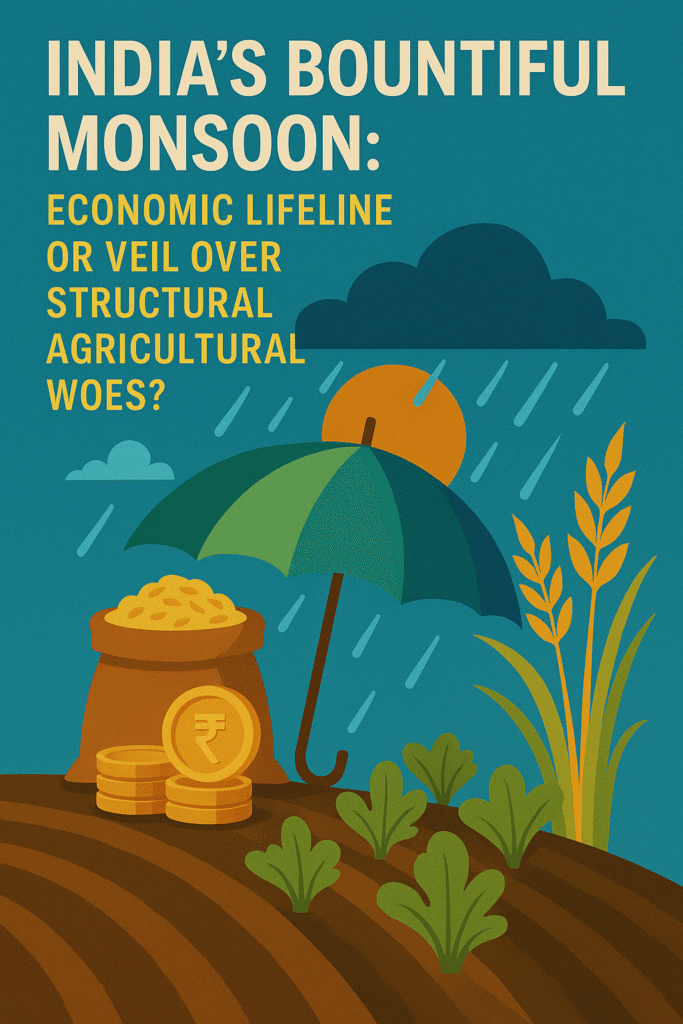
India’s forecast of a second consecutive year of above-average monsoon rains—105% of the long-term average—has sparked optimism about agricultural revival and broader economic growth. While robust rains could bolster crop yields, tame food inflation, and stimulate rural demand, this apparent boon risks overshadowing persistent structural vulnerabilities in India’s agrarian economy and the urgent need for systemic reforms.
The monsoon’s critical role cannot be overstated: it delivers 70% of India’s annual rainfall, irrigates nearly half of its unirrigated farmland, and sustains the livelihoods of millions. A second strong monsoon could boost production of key crops like rice, wheat, and pulses, potentially increasing agricultural GDP growth beyond the current 3.5% and supporting the national economy, which remains heavily reliant on rural consumption. Economists project that abundant harvests could lower food prices, which have stubbornly hovered around 6-7% annually, offering respite to households and enabling the Reserve Bank of India to maintain accommodative monetary policies FMCG, tractors, fertilizers, and other industries related to rural demand are also expected to gain, supporting India’s growth story.
However, this optimism masks deeper challenges. India’s agricultural sector remains perilously monsoon-dependent despite decades of claims about irrigation expansion. Only 54% of farmland is irrigated, leaving millions of farmers vulnerable to even minor rainfall deviations. The celebration of back-to-back good monsoons ignores the reality that climate change is making rainfall patterns increasingly erratic. For instance, 2023 saw uneven distribution, with floods in Assam and droughts in Bihar coexisting, causing localized crop losses. A 105% national average means little if rains are poorly distributed or excessive, as seen in 2022 when floods damaged 5 million hectares of crops.
Moreover, the focus on monsoon-driven growth perpetuates a cycle of complacency in addressing systemic issues. Post-harvest losses, estimated at $14 billion annually due to inadequate storage and supply chain inefficiencies, continue to undermine productivity gains. India’s food inflation is still unstable despite its abundant harvests because of market manipulation, export restrictions, and hoarding. The government’s Minimum Support Price (MSP) system, while politically sacrosanct, disproportionately benefits rice and wheat farmers in a few states, neglecting crops like pulses and oilseeds where India remains import-dependent.
The monsoon’s economic impact also highlights inequities. While large agribusinesses and middlemen capitalize on surplus production, smallholder farmers—who constitute 86% of India’s farming community—often sell at distress prices due to limited bargaining power and debt burdens. Rural wage growth, a key indicator of economic health, has stagnated at 4-5%, lagging behind inflation and failing to translate harvest gains into sustainable prosperity.
From a fiscal perspective, good monsoons could reduce pressure on the exchequer. Lower food inflation might ease the burden of subsidies, which consumed 8% of the 2024-25 budget. However, this temporary relief could delay much-needed investments in drip irrigation, cold storage infrastructure, and climate-resilient crop varieties. The government’s recent push for digital agriculture and farm reforms, while promising, lacks scalability and on-ground implementation.
Globally, India’s agricultural output shapes international markets. A surplus could stabilize global grain prices but may also revive export restrictions, as seen in 2022 when wheat and rice export bans disrupted trade. Conversely, overproduction risks groundwater depletion—already critical in Punjab and Haryana—as farmers intensify water-guzzling crop cycles, trading short-term gains for long-term environmental costs.
In conclusion, while back-to-back above-average monsoons offer a reprieve, they are not a panacea. True agricultural resilience demands reducing monsoon dependency through irrigation expansion, supply chain modernization, and diversification into high-value crops. Policymakers must leverage this optimism to address structural flaws rather than perpetuate a rain-fed growth model. Until then, India’s agrarian economy remains a gamble on the skies—a risky wager in an era of climate uncertainty.
This article was published on Publicfinance.pk
Source: www.reuters.com
